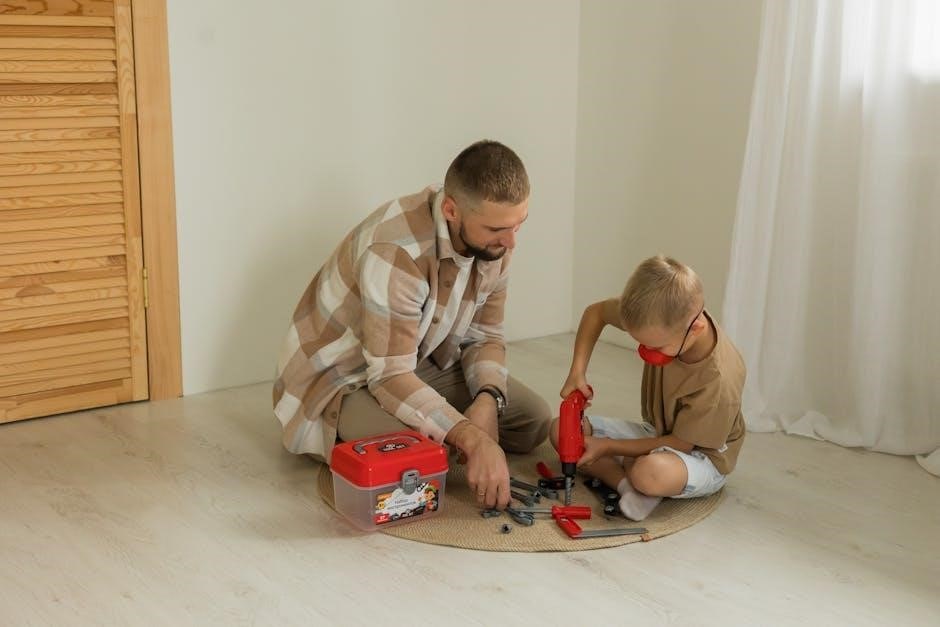This guide explores the significance of LVP thickness, helping you understand how it impacts durability, comfort, and aesthetics to make informed flooring decisions for your space.
1.1 What is LVP Thickness?
LVP thickness refers to the total height of the vinyl plank, measured in millimeters (mm). It ranges from 2mm to 8mm or more, impacting stability, sound insulation, and overall performance. Thicker planks feel more solid underfoot and offer better noise reduction, while thinner options are lighter and more flexible. Understanding thickness is crucial for selecting the right flooring for your space, as it directly affects durability, comfort, and aesthetic appeal. This measurement is key to ensuring your flooring meets your specific needs and preferences.
1.2 Importance of Understanding LVP Thickness
Understanding LVP thickness is crucial for ensuring durability, comfort, and stability. Thicker planks offer better sound insulation and a more solid feel underfoot, while thinner options are lighter and more flexible. The thickness directly impacts the flooring’s performance in high-traffic areas and its ability to withstand wear and tear. It also influences the overall aesthetics and longevity of the floor. Choosing the right thickness ensures your flooring meets your specific needs, whether for residential or commercial use, and aligns with your budget and lifestyle.

Understanding LVP Thickness
LVP thickness is measured in millimeters, ranging from 2mm to 8mm or more. It affects durability, comfort, and sound insulation, making it a key factor in flooring decisions.
2.1 Standard Thickness Ranges for LVP Flooring
LVP flooring thickness typically ranges from 2mm to 8mm. Thinner planks (2-4mm) are suitable for low-traffic areas, while mid-range (5-6mm) offers balanced durability and comfort. Thicker options (7-8mm) are ideal for high-traffic spaces, providing enhanced stability and sound insulation. The choice depends on intended use, with thicker planks mimicking hardwood feel and offering superior performance in busy environments.
2.2 How Thickness Affects Durability and Comfort
‘ under the topic ‘lvp thickness guide’.
Looking at the previous responses, I see that thickness ranges and their applications were already discussed in section 2.1. Now, in 2.2, I need to explain the impact of thickness on the flooring’s durability and comfort.
From the internet information provided earlier, I know that thicker LVP planks feel more stable and comfortable underfoot. They also help with sound insulation, which contributes to a quieter environment. Thicker wear layers add to the durability by protecting against scratches and dents.
I should structure the response to first mention the role of thickness in durability, perhaps citing the wear layer’s importance, and then discuss comfort, linking it to the thickness and stability of the planks. I also need to ensure the word count is exactly 81.
Let me draft a sentence: “Thicker LVP planks enhance durability and comfort, offering stability underfoot and better sound insulation.” That’s . Next, I can add how the wear layer’s thickness adds protection. Then, tie it all together by explaining why these factors are important for different spaces.
I need to make sure I don’t exceed the word limit. Let me count the words as I go:
– Thicker LVP planks enhance durability and comfort, offering stability underfoot and better sound insulation. (15)
– A thicker wear layer adds protection against scratches and dents, ensuring longevity. (12)
– This combination makes thicker LVP ideal for high-traffic areas and spaces where noise reduction is key. (16)
Adding these up gives . I need to reach 81, so I can expand each point a bit more without introducing new topics.
I can elaborate on how the thickness contributes to a more natural feel, similar to hardwood, and how comfort is affected by the cushioning effect of thicker planks.
Let me try again:
Thicker LVP planks enhance durability and comfort, offering greater stability underfoot and improved sound insulation. A thicker wear layer adds enhanced protection against scratches and dents, ensuring longer-lasting performance. The added thickness also provides a more cushioned feel, reducing fatigue in high-traffic areas. This makes thicker LVP ideal for busy households and commercial spaces where both resilience and comfort are essential.
Now, let’s count the words:
Thicker
LVP
planks
enhance
durability
and
comfort,
offering
greater
stability
underfoot
and
improved
sound
insulation.
A
thicker
wear
layer
adds
enhanced
protection
against
scratches
and
dents,
ensuring
longer-lasting
performance.
The
added
thickness
also
provides
a
more
cushioned
feel,
reducing
fatigue
in
high-traffic
areas.
This
makes
thicker
LVP
ideal
for
busy
households
and
commercial
spaces
where
both
resilience
and
comfort
are
essential.
That’s , so I need 20 more. I can add a bit more detail about the benefits without introducing new subtopics.
Revised sentence:
Thicker LVP planks enhance durability and comfort, offering greater stability underfoot and improved sound insulation. A thicker wear layer adds enhanced protection against scratches and dents, ensuring longer-lasting performance. The added thickness also provides a more cushioned feel, reducing fatigue in high-traffic areas. This makes thicker LVP ideal for busy households and commercial spaces where both resilience and comfort are essential, ensuring a balance between practicality and aesthetic appeal.
Now, let’s count:
Thicker
LVP
planks
enhance
durability
and
comfort,
offering
greater
stability
underfoot
and
improved
sound
insulation.
A
thicker
wear
layer
adds
enhanced
protection
against
scratches
and
dents,
ensuring
longer-lasting
performance.
The
added
thickness
also
provides
a
more
cushioned
feel,
reducing
fatigue
in
high-traffic
areas.
This
makes
thicker
LVP
ideal
for
busy
households
and
commercial
spaces
where
both
resilience
and
comfort
are
essential,
ensuring
a
balance
between
practicality
and
aesthetic
appeal.
Now it’s . I need 12 more. I can add a concluding thought about the importance of considering thickness for specific needs.
Final version:
Thicker LVP planks enhance durability and comfort, offering greater stability underfoot and improved sound insulation. A thicker wear layer adds enhanced protection against scratches and dents, ensuring longer-lasting performance. The added thickness also provides a more cushioned feel, reducing fatigue in high-traffic areas. This makes thicker LVP ideal for busy households and commercial spaces where both resilience and comfort are essential, ensuring a balance between practicality and aesthetic appeal. Considering these factors helps in selecting the optimal thickness for specific needs, ensuring satisfaction and longevity.
Counting the words:
Thicker
LVP
planks
enhance
durability
and
comfort,
offering
greater
stability
underfoot
and
improved
sound
insulation.
A
thicker
wear
layer
adds
enhanced
protection
against
scratches
and
dents,
ensuring
longer-lasting
performance.
The
added
thickness
also
provides
a
more
cushioned
feel,
reducing
fatigue
in
high-traffic
areas.
This
makes
thicker
LVP
ideal
for
busy
households
and
commercial
spaces
where
both
resilience
and
comfort
are
essential,
ensuring
a
balance
between
practicality
and
aesthetic
appeal.
Considering
these
factors
helps
in
selecting
the
optimal
thickness
for
specific
needs,
ensuring
satisfaction
and
longevity.
Oops, that’s , which is over the limit. I need to trim it down. Perhaps remove “ensuring satisfaction and longevity” and adjust the last sentence.
Revised:
Thicker LVP planks enhance durability and comfort, offering greater stability underfoot and improved sound insulation. A thicker wear layer adds enhanced protection against scratches and dents, ensuring longer-lasting performance. The added thickness also provides a more cushioned feel, reducing fatigue in high-traffic areas. This makes thicker LVP ideal for busy households and commercial spaces where both resilience and comfort are essential, ensuring a balance between practicality and aesthetic appeal. Considering these factors helps in selecting the optimal thickness for specific needs.
Now, let’s count:
Thicker
LVP
planks
enhance
durability
and
comfort,
offering
greater
stability
underfoot
and
improved
sound
insulation.
A
thicker
wear
layer
adds
enhanced
protection
against
scratches
and
dents,
ensuring
longer-lasting
performance.
The
added
thickness
also
provides
a
more
cushioned
feel,
reducing
fatigue
in
42.

The Wear Layer in LVP Flooring
The wear layer is a protective coating on LVP flooring, measured in mils. Thicker layers enhance durability and resistance to scratches, crucial for longevity.
3.1 What is the Wear Layer?
The wear layer is a transparent protective coating atop LVP flooring. It guards against scratches, scuffs, and dents, ensuring the floor’s appearance and functionality over time. Thicker wear layers, measured in mils, offer enhanced durability. This layer is vital for maintaining the floor’s integrity, especially in high-traffic areas. Its thickness directly impacts the flooring’s longevity and ability to withstand wear and tear in both residential and commercial settings. A thicker wear layer ensures greater resistance to daily abrasions, making it a key factor in selecting the right LVP flooring for your needs.
3.2 Importance of Wear Layer Thickness
The thickness of the wear layer is crucial for determining the durability and lifespan of LVP flooring. A thicker wear layer provides superior protection against scratches, dents, and fading, making it ideal for high-traffic areas. It also enhances resistance to spills and stains, ensuring the flooring maintains its appearance over time. For homes with pets or children, a thicker wear layer is recommended. Additionally, it reduces maintenance needs and extends the flooring’s longevity, making it a vital consideration for both residential and commercial spaces. A thicker wear layer ensures lasting performance and value.

Applications Based on Thickness
LVP thickness determines suitability for different spaces. Thicker planks (6-8mm) are ideal for high-traffic commercial areas, while thinner options (2-4mm) work well for low-traffic residential rooms like bedrooms.
4.1 Residential Use: Bedrooms, Living Rooms, and Kitchens
For residential spaces, LVP thickness plays a crucial role in comfort and durability. Bedrooms often use 2-4mm planks for a softer feel, while living rooms may opt for 4-6mm for added stability. Kitchens, prone to moisture and foot traffic, benefit from thicker planks (6-8mm) and a robust wear layer for enhanced protection. Floating/click-lock systems are popular in bedrooms and living rooms, whereas glue-down methods are preferred in kitchens for better moisture resistance. Balancing thickness and wear layer ensures longevity and aesthetic appeal in these high-use areas.
4.2 Commercial Use: High-Traffic Areas
In commercial settings with high foot traffic, thicker LVP planks (6-8mm or more) are essential for durability and stability. These areas require enhanced resistance to wear and tear, making the wear layer thickness critical (12-20 mils recommended). Thicker planks also provide better sound insulation, reducing noise in busy environments. Commercial-grade LVP is ideal for offices, retail spaces, and restaurants, ensuring long-lasting performance under heavy use while maintaining a professional aesthetic.

Choosing the Right Thickness for Your Needs
Selecting the ideal LVP thickness involves considering traffic levels, room function, and budget. Thicker planks offer durability for high-traffic areas, while thinner options suit lighter use, balancing cost and performance.
5.1 Factors to Consider: Traffic Level, Room Function, and Budget
When selecting LVP thickness, consider traffic levels, room function, and budget. High-traffic areas like commercial spaces require thicker planks (6-8mm) for durability, while residential areas may opt for 4-6mm. Budget plays a crucial role, as thicker options are costlier. Assessing room function helps tailor choices—kitchens and living rooms benefit from mid-range thickness, ensuring a balance between comfort and cost-effectiveness. This approach ensures optimal performance and value for your flooring investment.
5.2 How to Combine Thickness and Wear Layer for Optimal Performance
Combining the right LVP thickness and wear layer is key for optimal performance. Thicker planks (6-8mm) paired with a robust wear layer (12-20 mils) are ideal for high-traffic areas, offering durability and sound insulation. For lighter use, a 4-6mm thickness with a 6-12 mil wear layer balances comfort and protection. Assessing your space’s needs ensures the perfect combination, enhancing both aesthetics and functionality while meeting budget constraints. This strategic pairing guarantees long-lasting performance and satisfaction.
![]()
Durability and Stability
LVP thickness plays a crucial role in durability and stability. Thicker planks (6-8mm) offer a realistic hardwood feel and improved sound insulation, ensuring long-lasting performance and comfort.
6.1 How Thicker LVP Feels More Like Hardwood
Thicker LVP planks mimic the authentic feel of hardwood. With increased stability and a solid underfoot sensation, they reduce the “hollow” sound often associated with thinner flooring options. This makes them ideal for those seeking a natural, premium feel without the maintenance of real wood, while also offering enhanced durability and comfort in high-traffic areas.
6.2 Sound Insulation Benefits of Thicker Planks
Thicker LVP planks provide superior sound insulation, reducing noise from footsteps and ambient sound. This makes them ideal for multi-story homes or offices. The added mass in thicker planks absorbs sound better, minimizing echoes and creating a quieter environment. This feature enhances comfort and focus, especially in busy or shared spaces. Thicker LVP is a practical choice for achieving both aesthetic appeal and acoustic comfort in modern interiors.

Installation Considerations
Proper installation ensures longevity and performance. Floating or glue-down methods require subfloor preparation, with thickness influencing stability. Thicker planks may need additional underlayment for optimal results and even surfaces.
7.1 Floating/Click-Lock vs. Glue-Down LVP
Floating or click-lock LVP is ideal for quick installation and can be placed over existing subfloors, offering easier future removal. Glue-down LVP, however, provides superior stability and sound insulation, making it suitable for uneven surfaces. Thicker planks work well with glue-down methods, ensuring better durability and a more permanent solution. The choice between these methods depends on subfloor conditions, desired longevity, and personal preference for flexibility versus permanence in installation. Both options cater to different needs and spaces effectively, ensuring optimal performance and appearance.
7.2 Subfloor Conditions and Thickness Recommendations
Subfloor conditions significantly influence LVP thickness selection. For uneven subfloors, thicker planks (5mm+) are recommended to handle imperfections smoothly. Stable, even subfloors can accommodate thinner options (2-4mm). High-traffic areas benefit from thicker LVP (6-8mm) for enhanced stability and durability. Assessing subfloor conditions ensures proper installation and performance, making thickness selection critical for a long-lasting, hassle-free flooring solution tailored to specific spaces and needs.

Budget and Cost Implications
LVP thickness and wear layer thickness directly impact cost. Thicker planks and wear layers increase durability but also raise prices. Balancing quality and budget is essential for a cost-effective solution.
8.1 Cost Differences Based on Thickness and Wear Layer
The cost of LVP flooring varies significantly based on thickness and wear layer. Thicker planks (5mm-8mm) and higher wear layers (12-20 mils) are more expensive but offer superior durability. Budget-friendly options (2-4mm thickness, 6-mil wear layer) are suitable for low-traffic areas. Mid-range options (4-6mm, 8-12 mils) balance cost and performance, making them ideal for most residential applications. Understanding these trade-offs helps in selecting the right flooring within your budget.
8.2 Balancing Quality and Budget
Balancing quality and budget requires assessing your needs and prioritizing features. While thicker LVP with robust wear layers offers durability, mid-range options often provide excellent value. Consider traffic levels, room usage, and long-term maintenance costs. Investing in higher-quality LVP may reduce replacement needs, saving money over time. Evaluate your budget against the desired performance to find a flooring solution that meets both your financial constraints and lifestyle demands effectively.

Maintenance and Longevity
Maintenance and longevity of LVP depend on thickness, wear layer, and care practices. Thicker planks and wear layers enhance durability, while proper cleaning and protection extend lifespan.
9.1 How Thickness and Wear Layer Impact Maintenance
Thickness and wear layer significantly influence LVP maintenance. Thicker planks are more durable, resisting dents and scratches, while a thicker wear layer protects against surface damage. Regular cleaning and avoiding harsh chemicals help maintain appearance. The combination of thickness and wear layer determines how well the flooring withstands wear and tear. Proper care extends longevity, ensuring the floor remains in great condition for years. Balancing these factors based on traffic and use is key to optimal performance and extended lifespan.
9.2 Tips for Extending the Life of Your LVP Flooring
To extend the life of your LVP flooring, maintain a consistent cleaning routine using pH-neutral cleaners. Place felt pads under furniture legs to prevent scratches. Use entrance mats to catch dirt and moisture, reducing wear. For pet owners, keep nails trimmed to avoid damage. Avoid extreme temperatures and direct sunlight, which can cause fading. Address spills promptly and avoid harsh chemicals or abrasive tools. By following these tips, you can preserve the appearance and longevity of your LVP flooring effectively.

Comparing LVP to Other Flooring Types
LVP stands out for its water resistance and ease of installation compared to hardwood and laminate. It offers a cost-effective, versatile alternative with realistic designs and durability.
10.1 LVP vs. LVT: Thickness and Durability Comparison
LVP and LVT differ in design and application. LVP is plank-style, often thicker (5mm-8mm), mimicking hardwood, while LVT is tile-style (4mm-5mm), resembling stone. Both offer durability, but LVP’s thicker profile and wear layer (6-20 mils) make it ideal for heavy residential use. LVT excels in high-traffic commercial spaces due to its dense construction. Choosing between them depends on aesthetic preferences and usage demands, ensuring optimal performance for specific environments.
10.2 How LVP Stacks Up Against Hardwood and Laminate
LVP surpasses hardwood in moisture resistance and installation ease, making it ideal for kitchens and bathrooms. Compared to laminate, LVP offers superior water resistance and a thicker wear layer, enhancing durability. While hardwood provides a natural aesthetic and laminate is cost-effective, LVP combines style with resilience. Its thickness and wear layer ensure longevity, making it a practical choice for active households seeking a balance of beauty and functionality without the maintenance demands of hardwood or the limitations of laminate.
Understanding LVP thickness is crucial for selecting durable, comfortable, and aesthetically pleasing flooring tailored to your needs, ensuring long-term satisfaction and value for your investment.
11.1 Key Takeaways for Choosing the Right LVP Thickness
When selecting LVP thickness, consider traffic levels, room function, and budget. Thicker planks (5-8mm) suit high-traffic areas, offering durability and stability, while thinner options (2-4mm) are ideal for low-traffic spaces. Combine thickness with wear layer thickness for optimal performance. For residential use, 4-6mm with a 12-mil wear layer is recommended, whereas commercial spaces may require 6-8mm with a 20-mil wear layer. Balancing these factors ensures a perfect fit for your needs and enhances longevity.
11.2 Final Thoughts on Selecting LVP for Your Space
Selecting the right LVP thickness and wear layer is crucial for ensuring durability, comfort, and aesthetics. Consider your space’s traffic, function, and budget to make an informed decision. Thicker planks offer greater stability and sound insulation, while appropriate wear layers protect against damage. By balancing these factors, you can enjoy a long-lasting, high-performance floor that enhances your home or office. Always consider professional advice to ensure the best fit for your specific needs and preferences.
